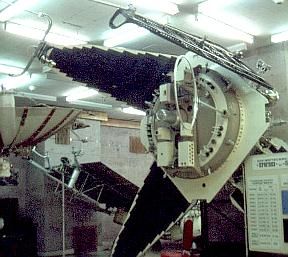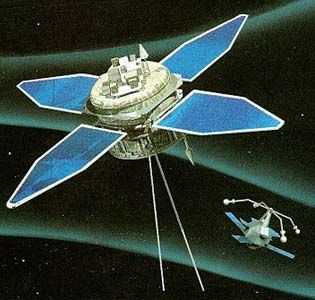
Home - Search - Browse - Alphabetic Index: 0- 1- 2- 3- 4- 5- 6- 7- 8- 9
A- B- C- D- E- F- G- H- I- J- K- L- M- N- O- P- Q- R- S- T- U- V- W- X- Y- Z
Prognoz-M
 Prognoz-M |
AKA: Interbol;SO-M2. Status: Operational 1995. First Launch: 1995-08-02. Last Launch: 1996-08-29. Number: 2 . Gross mass: 1,400 kg (3,000 lb).
It consisted of four spacecraft taking precise measurements of different portions of the Earth's magnetic fields. Interbol consisted of two pairs of spacecraft: one pair with orbits of 500 km by 200,000 km (tail probes) and one pair with orbits of 500 km by 20,000 km (auroral probes). Financial and other problems following the break-up of the Soviet Union and the Intercosmos organization delayed the launches until 1995-1996.
Each pair of spacecraft consisted of a Russian Prognoz-M (1,250 kg tail probes / 1,400 kg auroral probe) and a Czech Magion (50 kg ) satellite. The Prognoz-M spacecraft had a payload capacity of 250-350 kg, and was spin-stabilized with a diameter of 2.3 m, height of 5.0 m, and span with deployed antennas of 12.5 m x 22 m x 22 m. Four solar panels produced up to 250 W for the scientific payload from a total output of 900 W. Both probes carried a variety of plasma and charged particle detectors. Swedish, French, and Canadian instruments were also be on board. The Magion sub-satellites flew in close proximity to the Prognoz but could maneuver to as much as 10,000 km from the mother craft.
NASA NSSDC Master Catalog Description
The Interball (Interbol) Project is a multi-national effort that consists of four spacecraft: two main spacecraft of the Prognoz series, made in Russia, each with a small subsatellite made in Czechoslovakia. The main objective is to study the physical mechanisms responsible for the transmission of solar wind energy to the magnetosphere, its storage there, and subsequent dissipation in the tail and auroral regions of the magnetosphere, ionosphere, and atmosphere during magnetospheric substorms. A ground-based support group will provide coordinated and simultaneous ground-based data of many types, including observations from auroral and polar cap regions. Interball is an IACG-related mission. Key physical parameters will be generated, and will be available for exchange with other projects. Campaigns for intercomparison with the Wind and Geotail spacecraft are expected. One pair of spacecraft, Tail Probe and its subsatellite S2-X (X for the first letter of the Russian word for ``Tail''), will be launched into the magnetospheric tail. The second pair, Auroral Probe and S2-A (A for ``Auroral''), will have an orbit that crosses the auroral oval to observe the acceleration of auroral particles and the flow of electric currents that connect the magnetospheric tail with the conducting ionosphere. To study the equilibrium tail structure, during about half of each year the Tail Probe pair will cross the main parts of the magnetotail every four days. The Auroral Probe pair will support the Tail Probe pair with auroral region measurements. Each main spacecraft has more than twenty scientific instruments. The spacecraft is cylindrical, with spin axis toward the sun (within 10 degrees), and with spin period of ~120 s. The electric and magnetic field sensors are on booms connected to the ends of the solar panels. The subsatellites are small, each with about ten scientific instruments. The spin axis will be directed within 10 degrees of the sun, with a spin period of ~120 s, as with the main spacecraft. The subsatellites also carry gas-jet thrusters for limited control of the orbit. Separation distance will range from hundreds of kilometers to several tens of thousands of kilometers for the Tail Probe pair. Separation distance will range from hundreds of meters to hundreds of kilometers for the Auroral Probe pair. The Tail Probe has two telemetry systems, at up to 32 Kbps in real-time, with a memory mode capacity of 30 Mb in the RTK telemetry system and 120 Mb in the SSNI system. The Auroral Probe has similar capability plus the additional real-time-only STO system, capable of 40 Kbps. Each subsatellite has only the STO real-time telemetry system. For S2-X the rate can be varied from 2--40 kbps. The Tail Probe has an adapting alert mode while in the memory mode, allowing time resolutions that are the same as in the real-time mode. The aim is to have the highest time resolution available at the thin borders of magnetospheric regions or the sharp borders of some features. In the alert mode (triggered by an on-board computer monitoring plasma and field parameters), the bit rate is increased for plasma, field, and wave measurements. The duration of these alert periods is about 10 minutes, and there can be 5--6 of them during one orbit.
More at: Interbol-1.
Family: Earth, High earth orbit, Magnetosphere sat. Country: Russia. Launch Vehicles: R-7, Molniya 8K78M. Launch Sites: Plesetsk, Plesetsk LC43/3. Agency: MOM, Lavochkin bureau. Bibliography: 102, 2, 433, 6, 12979.
 | Interbol 1 Credit: Manufacturer Image |
1995 August 2 - . 23:59 GMT - . Launch Site: Plesetsk. Launch Complex: Plesetsk LC43/3. LV Family: R-7. Launch Vehicle: Molniya 8K78M.
- Interbol 1 - . Payload: SO-M2 s/n 511. Mass: 1,250 kg (2,750 lb). Nation: Russia. Agency: MOM. Class: Earth. Type: Magnetosphere satellite. Spacecraft: Prognoz-M. Decay Date: 2000-10-16 . USAF Sat Cat: 23632 . COSPAR: 1995-039A. Apogee: 188,331 km (117,023 mi). Perigee: 4,426 km (2,750 mi). Inclination: 68.20 deg. Period: 5,461.60 min. Particles and fields research. Paired with Magion 4 subsatellite..
1996 August 29 - . 05:22 GMT - . Launch Site: Plesetsk. Launch Complex: Plesetsk LC43/3. LV Family: R-7. Launch Vehicle: Molniya 8K78M.
- Interbol 2 - . Payload: SO-M2 s/n 512. Mass: 1,400 kg (3,000 lb). Nation: Russia. Agency: VKS. Class: Earth. Type: Magnetosphere satellite. Spacecraft: Prognoz-M. USAF Sat Cat: 24293 . COSPAR: 1996-050C. Apogee: 18,604 km (11,559 mi). Perigee: 1,369 km (850 mi). Inclination: 63.60 deg. Period: 347.20 min. Auroral research. Paired with Magion 5 subsatellite..
Back to top of page
Home - Search - Browse - Alphabetic Index: 0- 1- 2- 3- 4- 5- 6- 7- 8- 9
A- B- C- D- E- F- G- H- I- J- K- L- M- N- O- P- Q- R- S- T- U- V- W- X- Y- Z
© 1997-2019 Mark Wade - Contact
© / Conditions for Use